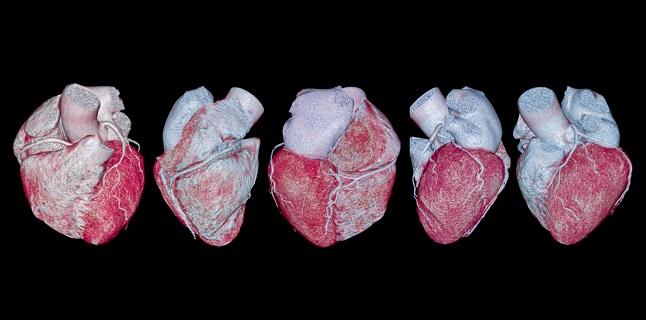CTA Matches Invasive Angiography for Stratification of NSTE ACS Risk
A VERDICT subanalysis supports CTA for predicting events in higher-risk patients than those now supported by guidelines.

Coronary computed tomographic angiography (CTA) may be as good as invasive coronary angiography (ICA) at predicting the long-term risk of adverse events in patients with non-ST-segment elevation acute coronary syndromes, according to a subanalysis of the VERDICT trial.
“The key thing is that it's pretty much equivalent whether you do an ICA or you do a CT to define the likelihood of events after the MI,” lead author Klaus F. Kofoed, MD, DmSc (University of Copenhagen, Denmark), told TCTMD. “So that was kind of reassuring that you don't need to do an ICA if you already have a CT.”
The findings carry special weight given the additional stress that COVID-19 has placed on health systems, he said. “The European guidelines have actually suggested that during these very difficult times if you have access to CT but not to invasive [angiography], CT would be a reasonable approach in NSTEMI patients to risk assess and define whether transport to an ICA facility would be helpful for the patients,” Kofoed explained.
Comparable Risk Assessment
The main results of the VERDICT trial, published in 2018, did not show a difference in long-term clinical outcomes between very early versus later invasive angiography in patients with NSTE ACS. A subsequent VERDICT analysis, looking only at the 1,023 patients who’d undergone preplanned CTA in the trial indicated that the imaging tool could be used to rule out obstructive CAD, thereby helping to hone the subset of patients who could indeed benefit from ICA.
For this latest analysis, published in the March 2, 2021, issue of the Journal of the American College of Cardiology, the researchers focused on the 978 patients from the original trial who underwent both coronary CTA and ICA, this time hoping to understand how well the presence or extent of CAD identified on CTA matched up with the prognostic weight of ICA.
Obstructive CAD was identified in 73.4% and 66.9% of patients by CTA and ICA, respectively, including 51% and 36.8% who were classified as high risk.
Over a median follow-up period of 4.2 years, 21.3% of patients reported the primary endpoint—a composite of all-cause death, nonfatal recurrent MI, hospital admission for refractory myocardial ischemia, or heart failure. Both coronary CTA and ICA predicted the heightened risk of the primary endpoint in patients with obstructive CAD as compared with nonobstructive disease. CTA did the same for patients who were at high risk versus those who weren’t, while ICA only trended in that direction.
Risk of the Primary Endpoint by CAD Type
|
|
HR |
95% CI |
|
Obstructive vs Nonobstructive |
|
|
|
CTA |
1.74 |
1.22-2.49 |
|
ICA |
1.54 |
1.13-2.11 |
|
High-risk vs Non-high-risk |
|
|
|
CTA |
1.56 |
1.18-2.07 |
|
ICA |
1.28 |
0.98-1.69 |
“One of the things that we didn't really anticipate was that there seems to be a tendency for CT to be somewhat stronger in terms of predicting outcome, especially in patients with a high extent of disease in many vessels, where the ICA wasn't able to decipher specifically those high-risk patients,” Kofoed said. “That was a clear signal that probably reflects that with CT you pick up more disease in the nonobstructive regions and that could add to the prognostic value of the CT.”
Importantly, note the authors, the use of ICA after CTA did not appear to further hone risk stratification in nonobstructive disease, nor did the use of CTA after ICA appear to add additional nuance in terms of risk prediction.
CTA might prove to be a useful tool for pinpointing patients for whom revascularization would be particularly helpful, suggested Kofoed. However, he continued, “there we would need a randomized trial to look at whether using CT as the first test in these patients would translate into an overall improvement with management. That's actually what we are hoping for after this study that we could convince the healthcare systems that we should do a randomized trial along these lines.”
Possible Gatekeeper to ICA
In an accompanying editorial, Michelle C. Williams, MBChB, PhD (University of Edinburgh, Scotland), and colleagues write that what’s novel here is the focus on coronary CTA in patients with NSTE ACS. Guideline and appropriate use criteria for CTA have typically addressed patients with low-to-intermediate risk of CAD, for example, in the setting of chest pain.
The current study, say Williams and colleagues, “therefore raises an alternative possible role for coronary CTA in patients presenting with NSTE ACS—as a gatekeeper to invasive coronary angiography,” they write, adding that ICA might be avoided in up to half of patients with high-risk disease if this strategy were widely adopted.
“A management strategy guided by coronary CTA might therefore enable the more appropriate use of invasive coronary angiography for patients with NSTE ACS, limiting it to those who could benefit from revascularization,” Williams and colleagues continue. “This would reduce the number of unnecessary invasive procedures and avoid potential complications associated with their conduct. Moreover, it might help streamline the patient pathway, expediting discharge, improving hospital capacity, and minimizing costs.”
In the past, critics of coronary CTA have pointed to its tendency to overestimate stenosis severity in patients at low risk of events, they comment. “However, in patients with NSTE ACS, this provides us with an important margin of error, and confidence that patients with potentially important disease are not missed by coronary CTA, as demonstrated by its excellent positive predictive value.”
Future research should investigate whether CTA results in fact change patient management or improve outcomes, Williams and colleagues say.
Commenting on the study for TCTMD, Udo Hoffmann, MD, MPH (Massachusetts General Hospital, Boston), praised the researchers both for performing blinded CT and including higher-risk patients. While pleased to see how well CTA detected obstructive disease in this setting, he said the clinical implications of that remain unclear.
“The elephant in the room is that if you do CT, then hopefully you can save [a percentage of patients from] invasive angiography, and also in these patients the question of early versus delayed angio is not any more a question because we have ruled out CAD,” Hoffmann said.
As such, it would have been more valuable if the researchers had run a hypothetical analysis of the data to assess what might have happened if the clinical care were guided by CTA then compared that with what happened in reality, he observed. “They could have said okay, we missed obstructive CAD in X patients but in these patients there were X adverse events. So they could have put a clinical value on the benefits of the CT.”
Hoffman also called for a renal function analysis of VERDICT in order to address any potential harms of contrast use between the two modalities, taking into account the risks in patients who ultimately go on to need revascularization.
Yael L. Maxwell is Senior Medical Journalist for TCTMD and Section Editor of TCTMD's Fellows Forum. She served as the inaugural…
Read Full BioSources
Kofoed KF, Engstrøm T, Sigvardsen PE, et al. Prognostic value of coronary CT angiography in patients with non–ST-segment elevation acute coronary syndromes. J Am Coll Cardiol. 2021;77:1044-1052.
Williams MC, Dweck MR, Newby DE. Coronary computed tomography angiography to triage patients with non–ST-segment elevation acute coronary syndrome. J Am Coll Cardiol. 2021;77:1053-1056.
Disclosures
- This study was funded by the Danish Agency for Science, Technology, and Innovation and the Danish Council for Strategic Research and the Research Council of Rigshospitalet, Copenhagen, Denmark.
- Kofoed reports receiving grants from the Danish Research Foundation during the conduct of the study, in addition to grants from the Research Council of Rigshospitalet, AP Moller og Hustru Chastine McKinney Mollers Fond, the Danish Heart Foundation, and Canon Medical Corporation, outside the submitted work.
- Williams is supported by the British Heart Foundation.
- Hoffmann reports no relevant conflicts of interest.





Comments